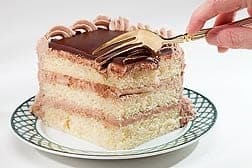White layer cakes can be made with more fiber or less fat, without significantly undermining many of the qualities of this favorite treat. These improvements can be made to cakes that are prepared at commercial bakeries or to the boxed mixes sold for home bakers, according to U.S. Department of Agriculture (USDA) food technologist Mukti Singh.
Her experiments with healthful, edible fiber focused on corn bran, the fiber-rich outer layer of corn kernels. She determined that purified, finely ground corn bran can be used as a substitute for up to 20 percent of the flour called for in the American Association of Cereal Chemists‘ “gold standard” test recipe for white cake.
Using 20 percent corn bran fiber didn’t significantly impact qualities such as color or springiness (the unfrosted top surface of a good cake will spring back when gently touched). And, the 25 volunteer taste-tasters who sampled cake made with that amount of the fiber rated it as “acceptable.” In taste-tester terminology, that counts as a vote of confidence.
One slice of an 8-inch, 6-slice, two-layer white cake made with 20 percent corn bran fiber would provide about 5 grams of fiber, compared to about 1 gram from a conventional white layer cake.
Singh and colleagues Steven F. Vaughn and Sean X. Liu described the research in a 2012 article in Biocatalysis and Agricultural Biotechnology. The scientists are with the USDA Agricultural Research Service (ARS) National Center for Agricultural Utilization Research in Peoria, Ill. ARS is the USDA’s chief intramural scientific research agency.
The study is apparently among the few that provide publicly accessible data about the effects that relatively high concentrations of purified, finely ground corn bran can have on the quality of white cake.
 In the tests aimed at cutting fat, and its calories—without sacrificing quality—Singh worked with a patented, ARS-developed process that uses steam-jet cooking to encapsulate microdroplets of cooking oil (in this case, canola) with flour and water. The cream-textured mixture that results can then be dried to form a smooth-flowing, shelf-stable powder that offers busy bakers the convenience of not having to pour, measure or clean up any oil.
In the tests aimed at cutting fat, and its calories—without sacrificing quality—Singh worked with a patented, ARS-developed process that uses steam-jet cooking to encapsulate microdroplets of cooking oil (in this case, canola) with flour and water. The cream-textured mixture that results can then be dried to form a smooth-flowing, shelf-stable powder that offers busy bakers the convenience of not having to pour, measure or clean up any oil.
For this preliminary research, Singh used only 25 percent of the cooking oil called for in the gold-standard recipe. In a 2012 issue of the Journal of Food Processing and Technology, and elsewhere, Singh has reported that cakes made with the flour-oil-water “composites” were softer and springier, and stayed moist longer, than cakes made with the same amount of nonencapsulated flour, oil, and water.
The experiments provide a foundation for further research, including taste-testing.



